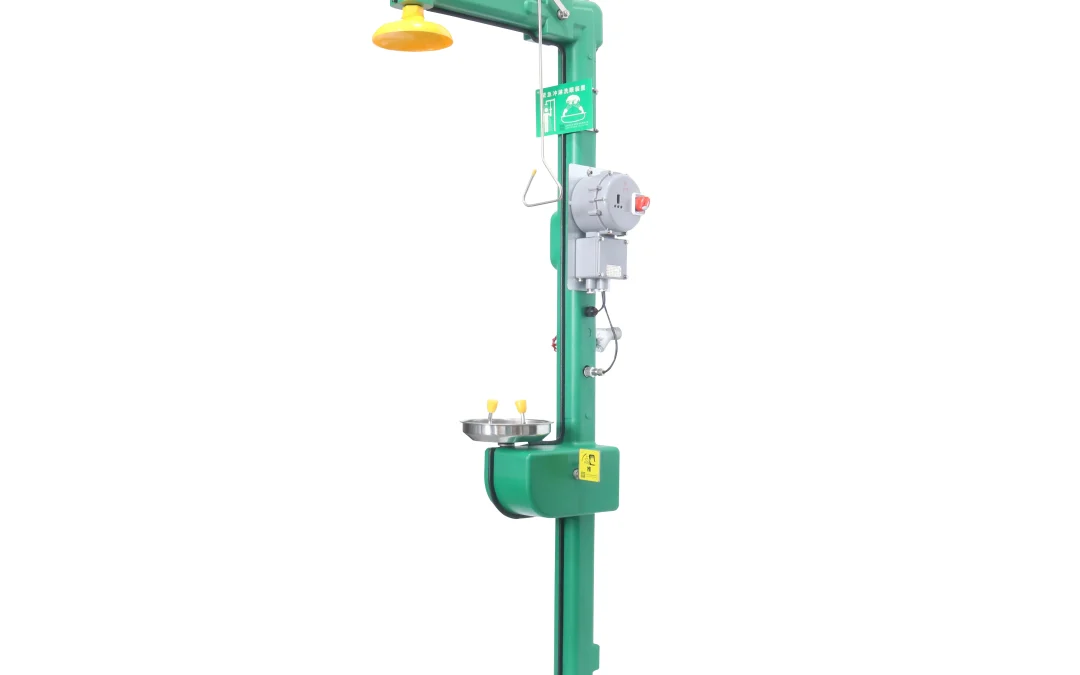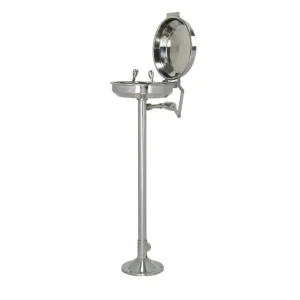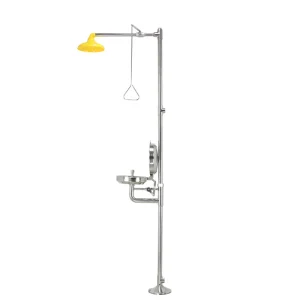I. Pre-Use Preparation
- Locate the Eyewash Station
- Ensure it is installed within 10 seconds’ reach (15 meters) of hazardous areas, with clear signage and unobstructed access.
- Verify the station is operational:
- Dust caps are intact.
- No leaks or discolored water.
- Water flow is steady (test monthly).
- Personal Protective Equipment (PPE)
- Remove contaminated clothing/gloves immediately to prevent further exposure.
- Wash hands before activating the station to avoid secondary contamination.
II. Step-by-Step Operation
- Activate the Eyewash
- Remove dust caps: Lift or twist off the protective covers on the eyewash nozzles.
- Start water flow:
- Hand-operated: Push the lever/handle downward or sideways (direction varies by model).
- Foot-operated: Step on the pedal (ideal for hands-free use when holding eyelids open).
- Flow requirements:
- Water temperature: 16°C–38°C (avoid freezing or scalding).
- Flow rate: ≥1.5 liters/minute for at least 15 minutes (30 minutes for strong acids/alkalis).
- Flush Eyes
- Position: Lean forward slightly to keep water from draining into the face/mouth.
- Technique:
- Hold eyelids open with fingers to ensure water contacts the entire eye, including under lids and corners.
- Roll eyes slowly (up/down/side-to-side) to rinse all areas.
- Duration: Continue flushing for the full recommended time, even if pain subsides.
- Deactivate the Station
- Release the lever/handle or lift the foot pedal to stop water flow.
- Replace dust caps to prevent contamination.
III. Post-Use Actions
- Seek Medical Help
- Visit a hospital/clinic immediately, even if symptoms improve. Some chemicals cause delayed injuries.
- Report and Maintain
- Inform your supervisor or safety officer about the incident.
- Document the event (time, chemical involved, duration of flushing).
- Equipment Maintenance
- Weekly checks: Test water flow, inspect for debris, and ensure dust caps are clean.
- Monthly tasks:
- Clean nozzle filters to prevent clogging.
- In cold climates, check for frozen pipes (install anti-freeze devices if needed).
- Annual servicing: Have a professional inspect the station and replace worn parts.
IV. Critical Safety Notes
- Prohibited Actions
- Do not use the eyewash for non-emergency purposes (e.g., washing faces).
- Never rinse other body parts (use a safety shower instead).
- Avoid sharing the eyewash with others to prevent cross-contamination.
- Special Scenarios
- Strong acids (e.g., sulfuric acid):
- Wipe away visible chemicals with a dry cloth before flushing (to avoid heat generation from dilution).
- Solid particles in the eye:
- Blink rapidly to dislodge debris.
- If particles remain, seek professional help (do not rub eyes).
- Strong acids (e.g., sulfuric acid):
- Water Quality
- Use potable water or medically approved solutions (e.g., saline).
- For plumbed stations, install filters to remove sediments.
- For portable units, replace stored water every 6 months.
V. Emergency Companion Measures
- Safety Showers: If chemicals splash onto the body, activate the shower immediately and stand under it for 15+ minutes.
- First Aid Kits: Use sterile gauze to pat dry eyes after flushing (avoid rubbing).
- Training: All personnel handling hazardous materials must complete annual eyewash training and know evacuation routes.
Key Takeaway:
The eyewash station is a last-resort emergency tool. Always wear PPE, minimize chemical exposure, and prioritize rapid access to the station. Proper use can prevent severe eye injuries, but medical evaluation remains critical post-flushing.






